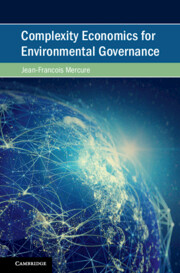Book contents
- Frontmatter
- Contents
- Figures
- Tables
- Preface
- Acknowledgements
- Part I The State of Knowledge and its use in Environmental Economics
- Part II A Positive Theory for Complexity Economics
- Part III Applied Complexity Economics for Environmental Governance
- 12 Risk-Opportunity Analysis for Transformative Policy Design and Appraisal
- 13 A Science–Policy Interface for the Energy–Water–Food Nexus
- 14 Technology Dynamics in a Rapid Low-Carbon Transition
- 15 Macroeconomics and Structural Change in a Rapid Low-Carbon Transition
- 16 Conclusions and Outlook
- References
- Index
13 - A Science–Policy Interface for the Energy–Water–Food Nexus
from Part III - Applied Complexity Economics for Environmental Governance
Published online by Cambridge University Press: 03 November 2022
- Frontmatter
- Contents
- Figures
- Tables
- Preface
- Acknowledgements
- Part I The State of Knowledge and its use in Environmental Economics
- Part II A Positive Theory for Complexity Economics
- Part III Applied Complexity Economics for Environmental Governance
- 12 Risk-Opportunity Analysis for Transformative Policy Design and Appraisal
- 13 A Science–Policy Interface for the Energy–Water–Food Nexus
- 14 Technology Dynamics in a Rapid Low-Carbon Transition
- 15 Macroeconomics and Structural Change in a Rapid Low-Carbon Transition
- 16 Conclusions and Outlook
- References
- Index
Summary
This chapter uses as a case study the energy-water-food nexus, one of the most complex sustainability challenges faced by the world, to propose an effective mode of operation of the science-policy interface for addressing `wicked’ policy problems. This case involves Brazil, where insufficiently understood interactions within the nexus are contributing to large-scale deforestation and land-use change, water and energy scarcity, and increased vulnerability to climate change. The reason is a combination of global and local environmental and economic change, putting unprecedented pressures on the Brazilian environment and ecosystems. The complex interdependence of developments at the global and local levels are analysed, highlighting the impact of global environmental and economic change on Brazil and, conversely, that of developments in Brazil for other countries and the world. A need is thus identified to adjust the scientific approach to these challenges as an enabling condition for stronger science-policy bridges for sustainability policy-making.
- Type
- Chapter
- Information
- Complexity Economics for Environmental Governance , pp. 328 - 349Publisher: Cambridge University PressPrint publication year: 2022



